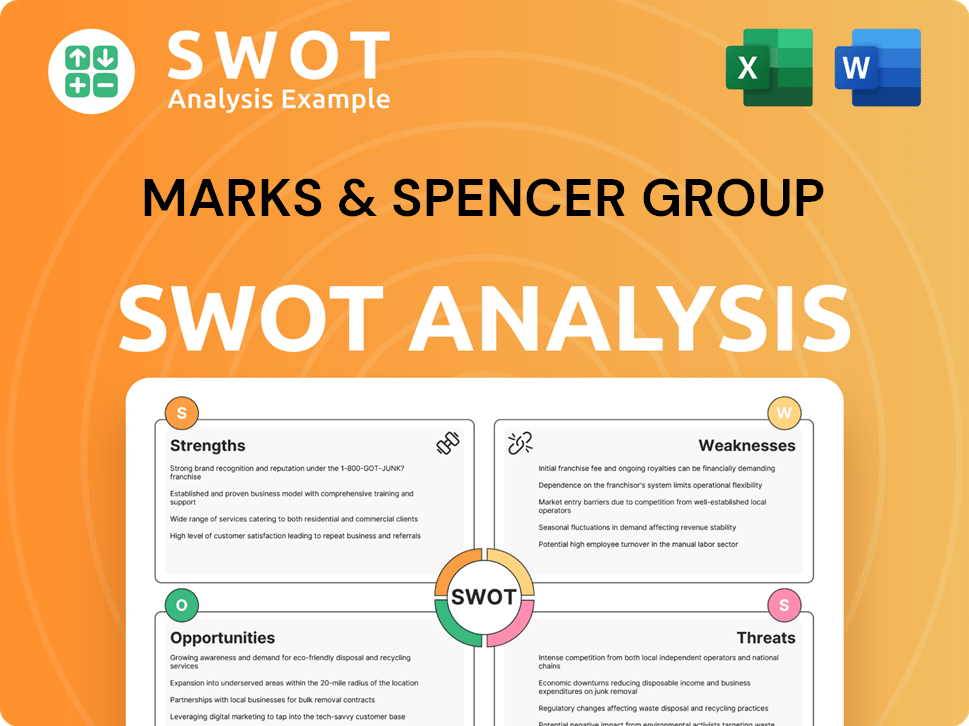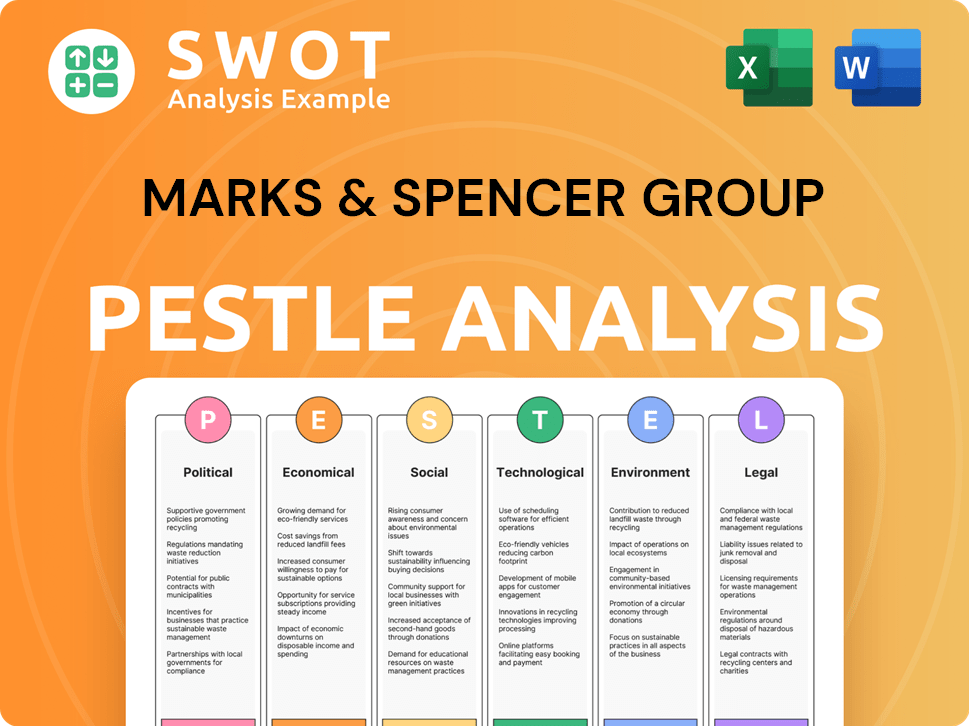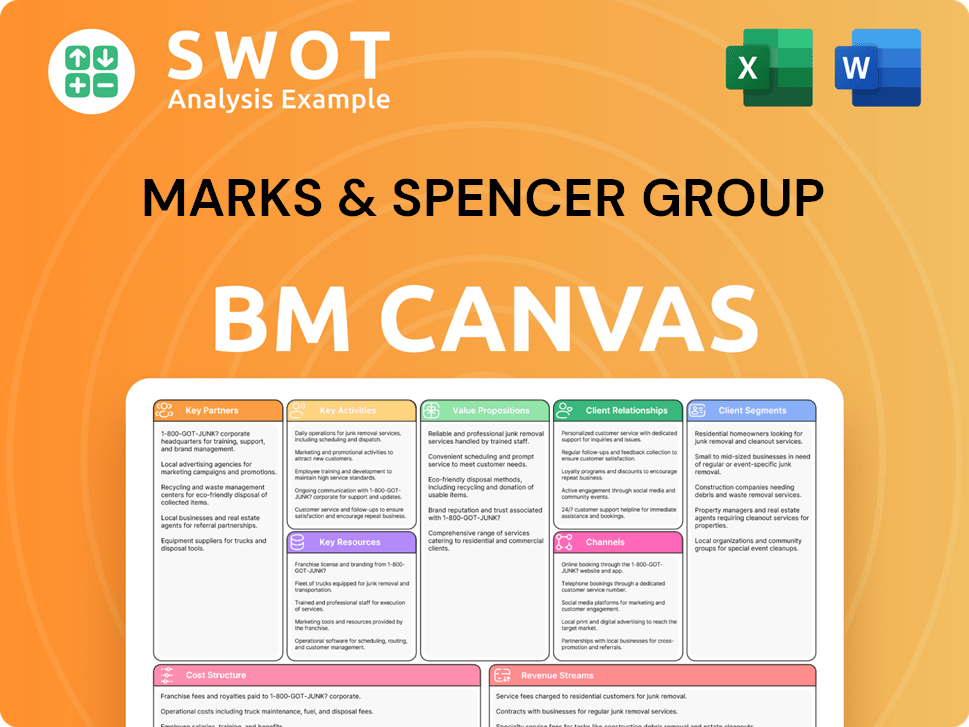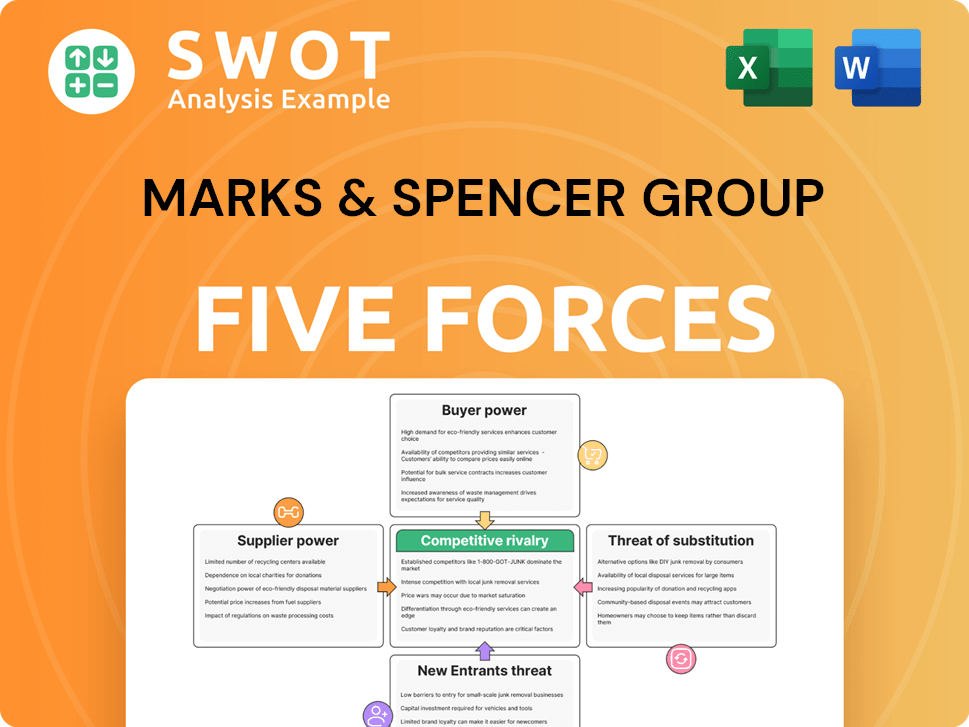Marks & Spencer Group Bundle
Can Marks & Spencer Maintain Its Market Position in Today's Retail Arena?
Marks & Spencer, a British retail icon, faces a complex and ever-shifting competitive landscape. Its ability to adapt to changing consumer preferences and the rise of e-commerce will be crucial for future success. Understanding its rivals and how M&S differentiates itself is key to evaluating its strategic direction.

To understand Marks & Spencer's position, we'll delve into the Marks & Spencer Group SWOT Analysis, examining its strengths and weaknesses in the context of its competitors. This analysis will explore the dynamics of the UK retail market and identify key players influencing the Marks & Spencer competitive landscape. We'll also investigate how M&S aims to achieve a competitive advantage M&S in a sector defined by intense retail industry competition.
Where Does Marks & Spencer Group’ Stand in the Current Market?
Marks & Spencer (M&S) holds a distinctive market position within the UK retail landscape, primarily known for its strong presence in food, clothing, and home sectors. The company's core operations revolve around these three key divisions, with a significant focus on quality and value. M&S has historically maintained a significant share in the UK food market, particularly in premium ready meals and fresh produce.
The value proposition of M&S centers on offering high-quality products, a strong brand reputation, and a convenient shopping experience. This is reflected in its food offerings, which emphasize premium and convenience, and in its clothing and home divisions, where the focus is on style, value, and availability. M&S has been undergoing a transformation to regain market share, focusing on improving style, value, and availability.
Geographically, M&S's primary presence remains in the UK, where it operates a vast network of stores and a growing online platform. The company has also maintained an international presence, though its global footprint has been streamlined in recent years to focus on profitable markets. Customer segments served by M&S are broad, ranging from value-conscious shoppers to those seeking premium and quality products, particularly in its food offering.
M&S has a significant market share in the UK food market, particularly in premium segments. While exact figures for early 2025 are not yet available, historical data shows a strong position. The 'Food' division reported a strong performance in the 13 weeks to 30 December 2023, with sales up 8.9%, indicating continued strength in this segment.
The clothing and home divisions have been undergoing a transformation. Sales increased by 5.5% in the 13 weeks to 30 December 2023. This indicates positive momentum. M&S is focusing on improving style, value, and availability to regain market share in this competitive sector.
M&S has significantly invested in its e-commerce capabilities to enhance its online presence and customer experience. This includes a partnership with Ocado. This digital transformation is crucial for competing in the modern retail environment.
M&S has demonstrated resilience in its financial performance. The Q3 FY24 trading statement showed robust financial health, with positive sales growth across key divisions. This positive performance reflects the effectiveness of M&S's strategic initiatives.
M&S holds a particularly strong position in the UK food retail sector, especially for quality and convenience. Its clothing and home divisions continue to compete in a highly saturated market, requiring continuous innovation and adaptation. To understand more about the competitive landscape, consider reading a detailed analysis of the Marks & Spencer competitive landscape.
- Focus on premium and convenience in food.
- Emphasis on style, value, and availability in clothing and home.
- Digital transformation to enhance online presence.
- Strategic partnerships to improve market reach.
Marks & Spencer Group SWOT Analysis
- Complete SWOT Breakdown
- Fully Customizable
- Editable in Excel & Word
- Professional Formatting
- Investor-Ready Format

Who Are the Main Competitors Challenging Marks & Spencer Group?
The Marketing Strategy of Marks & Spencer Group reveals a complex competitive landscape. Marks & Spencer (M&S) faces a diverse range of competitors across its food, clothing, and home goods sectors. Understanding the M&S competitors is crucial for assessing its market position and future prospects.
The Marks & Spencer competitive landscape is shaped by both direct and indirect rivals. These competitors vary in size, business model, and target customer, creating a dynamic environment. Analyzing these competitors helps to understand the challenges and opportunities M&S faces in the UK retail market.
In the food sector, M&S competes with major UK supermarket chains like Tesco, Sainsbury's, Asda, and Morrisons. These competitors focus on price, convenience, and a broad product range. Discounters such as Aldi and Lidl also pose significant challenges due to their competitive pricing strategies.
Premium food retailers like Waitrose are direct competitors in the quality and niche product segments. M&S's food offerings, including ready meals and fresh produce, directly compete with the premium lines offered by these supermarkets. The competition focuses on product quality and brand reputation.
In clothing and home goods, M&S faces competition from high-street fashion retailers like Next, Primark, and Zara. These competitors emphasize fashion trends, speed to market, and affordability. Department stores such as John Lewis also compete for market share in clothing and home goods.
Online pure-play retailers like ASOS and Boohoo, along with the growing e-commerce presence of traditional retailers, represent a significant indirect competitive threat. These retailers challenge M&S on convenience, selection, and pricing. The shift towards online shopping has intensified competition.
Emerging players and new business models, particularly in sustainable fashion and direct-to-consumer brands, are also disrupting the market. These companies push M&S to innovate its product lines and operational practices. The industry is constantly evolving with new entrants.
The 'battles' in these segments often revolve around capturing evolving consumer tastes, supply chain efficiency, and effective online engagement. M&S must adapt to these changing dynamics to maintain its market position. Key strategies include product innovation and operational improvements.
Several factors influence the competitive advantage M&S holds. These include brand reputation, product quality, store location, and online presence. M&S's ability to adapt to changing consumer preferences and market trends is critical for its success. The Marks & Spencer analysis reveals the importance of these factors.
- Product Range: Offering a diverse range of products across food, clothing, and home goods.
- Brand Reputation: Maintaining a strong brand image associated with quality and trust.
- Store Network: Leveraging a well-established network of physical stores.
- Online Presence: Enhancing its e-commerce capabilities to compete effectively online.
- Supply Chain Efficiency: Optimizing supply chain operations to reduce costs and improve responsiveness.
Marks & Spencer Group PESTLE Analysis
- Covers All 6 PESTLE Categories
- No Research Needed – Save Hours of Work
- Built by Experts, Trusted by Consultants
- Instant Download, Ready to Use
- 100% Editable, Fully Customizable

What Gives Marks & Spencer Group a Competitive Edge Over Its Rivals?
The competitive landscape for Marks & Spencer (M&S) is shaped by its brand heritage, quality focus, and strategic adaptations. M&S has cultivated a strong brand reputation, particularly in the UK, which provides a significant advantage in the competitive retail market. The company's focus on quality and its food offerings are key differentiators, helping it maintain a loyal customer base.
M&S's strategic moves involve leveraging its extensive store network alongside growing online capabilities. This omnichannel approach, including a partnership with Ocado for online food delivery, is crucial in the evolving retail environment. The company continuously refines its product design, value proposition, and supply chain efficiency to strengthen its position in clothing and home goods.
Analyzing the Marks & Spencer competitive landscape reveals a company adapting to industry changes while leveraging its core strengths. The company's ability to innovate and respond to market trends is critical for sustaining its competitive edge. Understanding the M&S competitors and their strategies is essential for assessing M&S's market position and future prospects.
M&S benefits from a strong brand reputation built over decades, synonymous with trust and quality, especially in the UK. This brand loyalty acts as a significant barrier to entry for competitors. The brand's heritage and association with quality products enhance its appeal to consumers.
The food division is a key differentiator, emphasizing quality, innovation, and ethical sourcing. M&S food sales consistently perform well, as demonstrated by an 8.9% increase in the 13 weeks to December 30, 2023. This focus allows M&S to command a premium and maintain a loyal customer base.
M&S has a broad physical presence with an extensive store network across the UK, providing numerous customer touchpoints. Its growing online capabilities, supported by the partnership with Ocado, enhance its reach and convenience. This omnichannel strategy is crucial in today's retail environment.
M&S leverages strong supply chain relationships, particularly in food, to ensure consistent quality and availability of its own-brand products. The Ocado partnership is a key strategic move to enhance its online presence. These partnerships and supply chain efficiencies are vital for maintaining a competitive edge.
M&S's competitive advantages are rooted in its brand equity, quality-focused food division, and omnichannel strategy. The company faces challenges from imitation and industry shifts, requiring continuous innovation and adaptation. Understanding the Marks & Spencer analysis reveals the company's strengths and areas for improvement.
- Strong Brand Reputation: Trust and quality are key brand attributes.
- Differentiated Food Offering: Emphasis on quality, innovation, and ethical sourcing.
- Omnichannel Strategy: Integrating physical stores with online capabilities.
- Strategic Partnerships: Leveraging partnerships like Ocado for online growth.
Marks & Spencer Group Business Model Canvas
- Complete 9-Block Business Model Canvas
- Effortlessly Communicate Your Business Strategy
- Investor-Ready BMC Format
- 100% Editable and Customizable
- Clear and Structured Layout

What Industry Trends Are Reshaping Marks & Spencer Group’s Competitive Landscape?
The retail industry is currently undergoing a significant transformation, significantly impacting the competitive landscape of companies like Marks & Spencer. This evolution is driven by technological advancements, changing consumer behaviors, and evolving regulatory landscapes. Understanding these dynamics is crucial for assessing the future prospects of M&S and its ability to maintain a strong market position, particularly in the UK retail market.
For a detailed look at the ownership structure, you can explore the Owners & Shareholders of Marks & Spencer Group. This provides valuable context for understanding the company's strategic direction and its ability to navigate the challenges and opportunities within the competitive environment.
Key trends shaping the industry include the growth of e-commerce, data analytics, and supply chain automation, which are transforming the retail landscape. Consumers now demand convenience, value, sustainability, and personalized experiences, influenced by global events. Regulatory changes, particularly concerning environmental and labor practices, also affect operational costs and consumer perception.
M&S faces challenges in maintaining relevance amidst online competition and discounters in food and clothing. Adapting the store estate to evolving shopping habits, optimizing omnichannel strategies, and ensuring competitive product pricing are ongoing hurdles. Managing rising operational costs and supply chain disruptions also poses significant challenges.
Opportunities lie in growing consumer demand for sustainable products, aligning with M&S's heritage. Leveraging data analytics for personalized customer experiences and optimizing inventory management is another avenue. Expanding online presence and refining click-and-collect services can capitalize on digital shopping trends. Strategic partnerships and exploring new product categories offer further growth potential.
M&S's competitive position is expected to evolve with continued investment in digital transformation and supply chain efficiencies. Its ability to remain resilient depends on its agility in responding to trends and effectively deploying strategies that balance heritage with future-oriented innovation. The company’s strong brand recognition and loyal customer base provide a solid foundation.
M&S's competitive advantage stems from its strong brand, loyal customer base, and heritage in quality products. The company is focusing on digital transformation, supply chain optimization, and sustainability to enhance its market position. Strategic partnerships, such as the Ocado venture, have expanded its reach and offerings.
- Digital Transformation: Investing in e-commerce platforms and data analytics to improve customer experience and operational efficiency.
- Sustainability Initiatives: Expanding the range of ethically sourced and sustainable products to meet consumer demand.
- Strategic Partnerships: Collaborating with other businesses to expand market access and product offerings.
- Supply Chain Optimization: Streamlining logistics and inventory management to reduce costs and improve responsiveness.
Marks & Spencer Group Porter's Five Forces Analysis
- Covers All 5 Competitive Forces in Detail
- Structured for Consultants, Students, and Founders
- 100% Editable in Microsoft Word & Excel
- Instant Digital Download – Use Immediately
- Compatible with Mac & PC – Fully Unlocked

Related Blogs
- What are Mission Vision & Core Values of Marks & Spencer Group Company?
- What is Growth Strategy and Future Prospects of Marks & Spencer Group Company?
- How Does Marks & Spencer Group Company Work?
- What is Sales and Marketing Strategy of Marks & Spencer Group Company?
- What is Brief History of Marks & Spencer Group Company?
- Who Owns Marks & Spencer Group Company?
- What is Customer Demographics and Target Market of Marks & Spencer Group Company?
Disclaimer
All information, articles, and product details provided on this website are for general informational and educational purposes only. We do not claim any ownership over, nor do we intend to infringe upon, any trademarks, copyrights, logos, brand names, or other intellectual property mentioned or depicted on this site. Such intellectual property remains the property of its respective owners, and any references here are made solely for identification or informational purposes, without implying any affiliation, endorsement, or partnership.
We make no representations or warranties, express or implied, regarding the accuracy, completeness, or suitability of any content or products presented. Nothing on this website should be construed as legal, tax, investment, financial, medical, or other professional advice. In addition, no part of this site—including articles or product references—constitutes a solicitation, recommendation, endorsement, advertisement, or offer to buy or sell any securities, franchises, or other financial instruments, particularly in jurisdictions where such activity would be unlawful.
All content is of a general nature and may not address the specific circumstances of any individual or entity. It is not a substitute for professional advice or services. Any actions you take based on the information provided here are strictly at your own risk. You accept full responsibility for any decisions or outcomes arising from your use of this website and agree to release us from any liability in connection with your use of, or reliance upon, the content or products found herein.